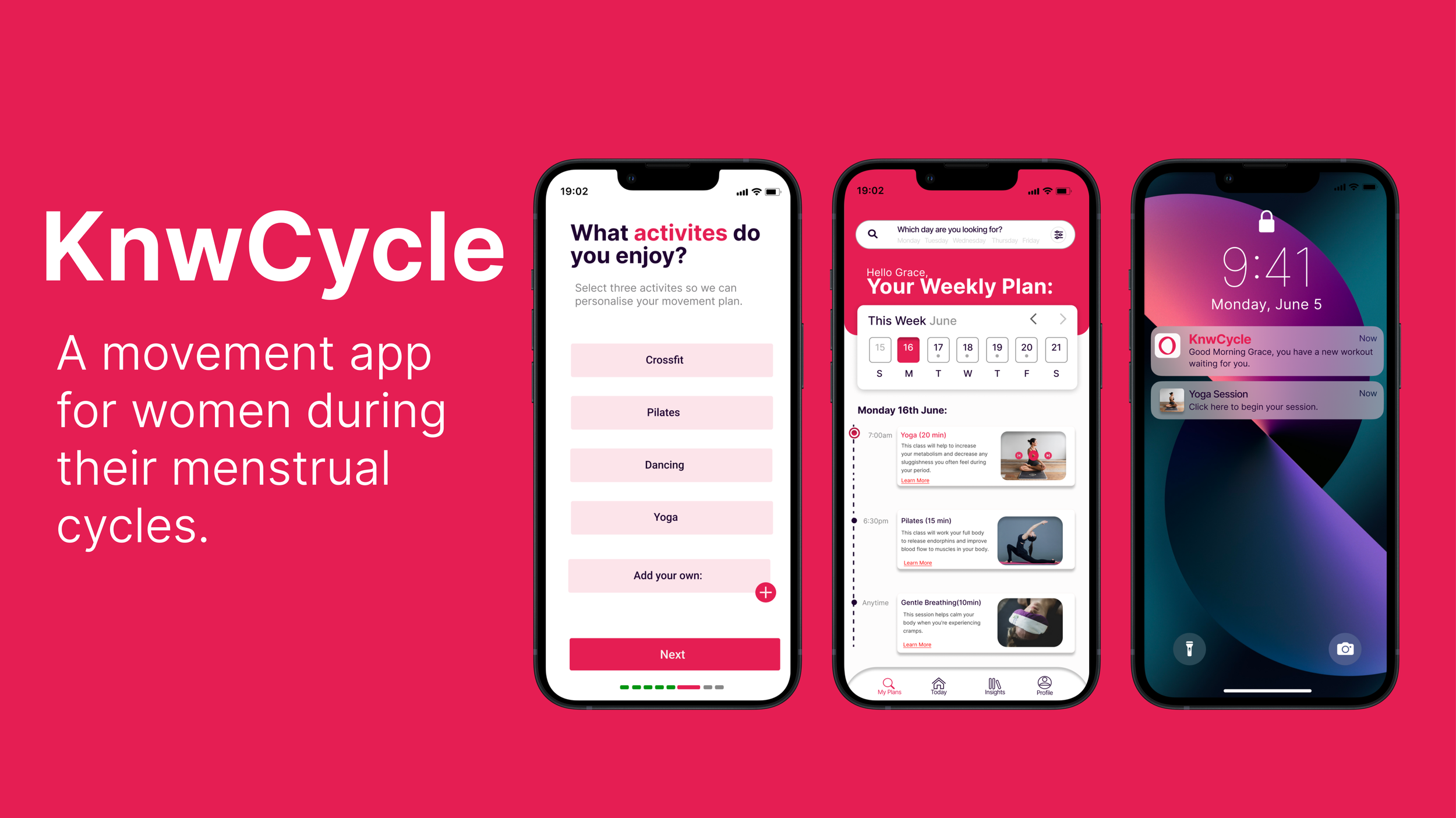
My Role
Solo student project for BrainStation UX/UI Bootcamp
Deliver iOS app design using the design thinking method
Timeline
10 Weeks (May - July 2022)
PROBLEMWomen avoid movement during their menstrual cycle
As a woman who has a menstrual cycle, I have noticed the positive impact movement has on reducing typical symptoms during my cycle. Yet, despite knowing this many women have reported that they avoid movement during their cycle. This sparked the question: why was there a disconnect in attitudes towards movement?
THE SOLUTION Personal movement plans are key
78% of women found that movement reduced typical symptoms during their menstrual cycle… however
WHITE PAPER RESEARCH Starting with white paper research, I began to draw from research articles on the topic of exercise, menstrual cycles, motivation and behaviour. Although a relatively new area of research I found an eye-opening statistic from Strava:
“… *34% of women reported avoiding physical activity during their menstrual cycle. Reasons included: embarrassment, fear of movement and excessive planning required to fit a busy work lifestyle…”
*according to FitrWoman responses from over 14,000 women on Strava from around the world.
COMPETITIVE ANALYSIS + THE GAP The competition had no MOVEMENT & MOOD aspect
After I analyzed the 3 most popular apps in the femtech space + 1 popular fitness app many follow from Instagram. I found that none of them had a personal movement and mood aspect to them. This finding combined with the valuation of the market being over $22 billion indicated to me that there is an opportunity for a solution.
USER INTERVIEWS My interviewees were 2x more likely to stay consistent with movement when offered a choice of activity.
I conducted interviews with 3 women who had tried online programs, followed fitness influencer plans or tried their own. I’ve asked them questions below to find trends on why attitudes varied amongst women.
I then organised my data through affinity mapping.
RESEARCH QUESTIONS:
1. Tell me about the last exercise plan you followed
2. What were your goals?
3. What was the most difficult part about trying to achieve your goal?
4. What motivated you to start in the first place?
5. What do you look for in a movement app?
THE MAIN INSIGHT None of the movement plans my interviewees used considered their menstrual cycle.
Based on the trends in my affinity map, I’ve noticed that women turn to online programmes but do not stick to them long-term due to issues such as overwhelm of choice, injury and lack of personal activity choice.
THE PERSONAFitness Enthusiast
DESIGN Redirection for the movement app
At first, I spent 2 weeks trying to design a movement app that considered the whole 28-day hormonal cycle, however, with a closer inspection of my research, I found it would be suitable to design for the menstrual cycle only, to begin with. Designing this way simplified the onboarding questions to suit delivering a minimal viable product.
HOW MIGHT WE …
Help women exercise according to their menstrual cycle in order to improve their mood and reduce typical symptoms?
TESTING + IMPROVEMENTS 3 Major improvements in my design
Based on three rounds of user testing from 15 peers + mentor feedback, I continually iterated my design over the span of 3 weeks.
THE FINAL SCREENS The Final Product
Mobile Prototype:
Responsive Website:
CONCLUSIONS + LESSONS LEARNED
This was my first end-to-end UX project! More than the outcome, the process taught me more about how to approach coming projects. For this project, I followed the double diamond human-centred approach. A few things I have learned:
Do not get attached to how you want a design to be. In the beginning, I had an Idea of where I wanted the design to go, even if it was bigger than the expectation of the project guidelines. But with time, I adopted an attitude of not getting attached to the way a design came to be & in turn offered me more creative space to design with a clearer vision.
Iterate, Iterate, Iterate! Accepting that the first draft will not be the last, is freeing, just design, then continue to iterate. Take on the feedback and apply it until a refined solution is found.
Listen to what the users ask for. For this project, I was humbled to learn about the pain points the women I interviewed had when it came to finding a movement plan that suits their lifestyle. Only through really listening can you learn to find the solutions to the designs you want to bring to life.
Practice simple UI. It sounds easy, but the simplest option is always the most beautiful.
Ps: If you are viewing from mobile, please open with desktop to view the prototype & responsive website in full.
What I learned for next time:
For more work inquiries, or to grab a coffee do email me at klaudiakercova@gmail.com ☕️✨
Thank you for reading! 🧠










